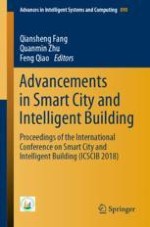The book entitled “Advancements in Smart City and Intelligent Building” is the Proceedings of the International Conference on Smart City and Intelligent Building (ICSCIB 2018) held in Hefei, China, September 15-16, 2018. It contains 58 papers in total categorized into 8 different tracks, on Building Energy Efficiency, Construction Robot and Automation, Intelligent Community and Urban Safety, Intelligentialization of Heating Ventilation Air Conditioning System, Information Technology and Intelligent Transportation Systems, New Generation Intelligent Building Platform Techniques, Smart Home and Utility, and Smart Underground Space, which cover a wide range areas of smart cities and intelligent buildings.
ICSCIB2018 provided an international forum for professionals, academics, and researchers to present the latest developments from interdisciplinary theoretical studies, computational algorithm developments and engineering applications in smart cities and smart buildings. This academic event featured many opportunities to network with colleagues from around the world in a wonderful environment. Its program covered invitation and presentations from scientists, researchers, and practitioners who have been working in the related areas to establish platforms for collaborative research projects in these fields. The conference invited leaders from industry and academia to exchange and share their experiences, present research results, explore collaborations and to spark new ideas, with the aim of developing new projects and exploiting new technology in these fields, and bridge theoretical studies and emerging applications in various science and engineering branches.
This book addresses the recent development and achievement in the field of smart city and intelligent building. It is primarily intended for researchers and students for undergraduate and postgraduate programs in the background of multiple disciplines including computer science, information systems, information technology, automatic control and automation, electrical and electronic engineering, and telecommunications who wish to develop and share their ideas, knowledge and new findings in smart city and intelligent building.
